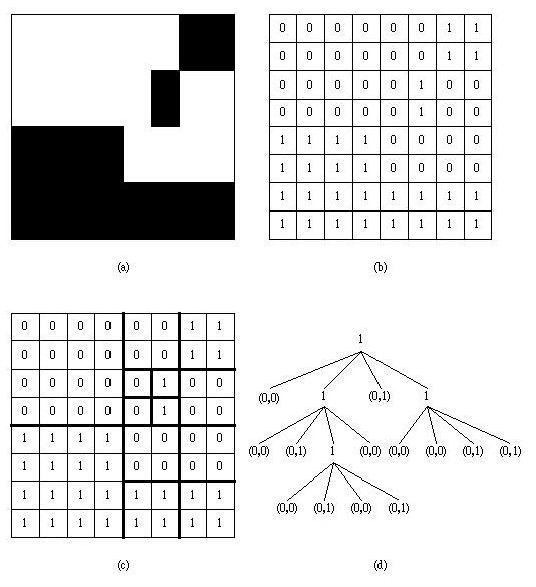当前你的浏览器版本过低,网站已在兼容模式下运行,兼容模式仅提供最小功能支持,网站样式可能显示不正常。
请尽快升级浏览器以体验网站在线编辑、在线运行等功能。
1610:Quad Trees
题目描述
A binary image, such as the one shown in Figure 2(a), is usually represented as an array of binary entries, i.e., each entry of the array has value 0 or 1. Figure 2(b) shows the array that represents the binary image in Figure 2(a). To store the binary image of Figure 2(b), the so-called quad tree partition is usually used. For an N * N array,N <= 512 and N = 2i for some positive integer i, if the entries do not have the same value, then it is partitioned into four N/2 * N/2 arrays, as shown in Figure 2(c). If an N/2*N/2 array does not have the same binary value, such as the upper right and
lower right N/2*N/2 arrays in Figure 2(c), then we can divide it into four N/4*N/4 arrays again. These N/4*N/4 arrays in turn can also, if needed, be divided into four N/8 * N/8 arrays, etc.. The quad tree partition is completed when the whole array
is partitioned into arrays of various size in which each array contains only one binary value. Figure 2(c) contains the arrays after the quad tree partition is completed.
Instead of storing the binary image of Figure 2(a), we only need to store the quad tree in the form as Figure 2(d) which is encoded from Figure 2(c). In Figure 2(d), each node represents an array of Figure 2(c) in which the root node represents the original array. If the value of a node in the tree is 1, then it means that its corresponding array needs to be decomposed into four smaller arrays. Otherwise, a node will have a pair of values and the first one is 0. It means that its corresponding array is not necessary to decompose any more. In this case, the second value is 0 (respectively,1) to indicate that all the entries in the array are 0 (respectively, 1). Thus, we only need to store the tree of Figure 2(d) to replace storing the binary image of Figure 2(a). The way to store the tree of Figure 2(d) can be represented by the following

Figure 2: A binary image (a), its array representation (b), its quad tree partition (c),and its quad tree representation (d).
code: (1)(0,0)(1)(0,1)(1)(0,0)(0,1)(1)(0,0)(0,0)(0,0)(0,1)(0,1)(0,0)(0,1)(0,0)(0,1). This
code is just to list the values of the nodes from the root to leaves and from left to right in each level. Deleting the parentheses and commas, we can obtain a binary number 100101100011000000010100010001 which is equal to 258C0511 in hexadecimal. You are asked to design a program for finding the resulting hexadecimal value for each given image.
lower right N/2*N/2 arrays in Figure 2(c), then we can divide it into four N/4*N/4 arrays again. These N/4*N/4 arrays in turn can also, if needed, be divided into four N/8 * N/8 arrays, etc.. The quad tree partition is completed when the whole array
is partitioned into arrays of various size in which each array contains only one binary value. Figure 2(c) contains the arrays after the quad tree partition is completed.
Instead of storing the binary image of Figure 2(a), we only need to store the quad tree in the form as Figure 2(d) which is encoded from Figure 2(c). In Figure 2(d), each node represents an array of Figure 2(c) in which the root node represents the original array. If the value of a node in the tree is 1, then it means that its corresponding array needs to be decomposed into four smaller arrays. Otherwise, a node will have a pair of values and the first one is 0. It means that its corresponding array is not necessary to decompose any more. In this case, the second value is 0 (respectively,1) to indicate that all the entries in the array are 0 (respectively, 1). Thus, we only need to store the tree of Figure 2(d) to replace storing the binary image of Figure 2(a). The way to store the tree of Figure 2(d) can be represented by the following

Figure 2: A binary image (a), its array representation (b), its quad tree partition (c),and its quad tree representation (d).
code: (1)(0,0)(1)(0,1)(1)(0,0)(0,1)(1)(0,0)(0,0)(0,0)(0,1)(0,1)(0,0)(0,1)(0,0)(0,1). This
code is just to list the values of the nodes from the root to leaves and from left to right in each level. Deleting the parentheses and commas, we can obtain a binary number 100101100011000000010100010001 which is equal to 258C0511 in hexadecimal. You are asked to design a program for finding the resulting hexadecimal value for each given image.
输入解释
There is an integer number k, 1 <= k <= 100, in the first line to indicate the number of test cases. In each test case, the first line is also a positive integer N indicating that the binary image is an N * N array, where N <= 512 and N = 2i for some positive integer i. Then, an N * N binary array is followed in which at least one blank is between any two elements.
输出解释
The bit stream (in hexadecimal) used to code each input array.
输入样例
3 2 0 0 0 0 4 0 0 1 1 0 0 1 1 1 1 0 0 1 1 0 0 8 0 0 0 0 0 0 1 1 0 0 0 0 0 0 1 1 0 0 0 0 0 1 0 0 0 0 0 0 0 1 0 0 1 1 1 1 0 0 0 0 1 1 1 1 0 0 0 0 1 1 1 1 1 1 1 1 1 1 1 1 1 1 1 1
输出样例
0 114 258C0511
最后修改于 2020-10-29T06:08:51+00:00 由爬虫自动更新
共提交 0 次
通过率 --%
| 时间上限 | 内存上限 |
| 1000 | 10000 |
登陆或注册以提交代码